Sunday, November 30, 2014
Or: Concepts of Space
1976 according to Cullinane:

1976 according to Plotnick:

“Irony and ridicule are entertaining and effective, and . . .
at the same time they are the agents of a great despair
and stasis in U.S. culture.” — David Foster Wallace,
as quoted by Adam Kirsch today at Salon
Comments Off on Agents of a Great Despair
Continued from Black Friday …
"Tell me no secrets, tell me some lies."
— Don't It Make My Brown Eyes Blue
Comments Off on Electric Dreams
Reality's Mirror: Exploring the Mathematics of Symmetry —
"Here is a book that explains in laymen language
what symmetry is all about, from the lowliest snowflake
and flounder to the lofty group structures whose
astonishing applications to the Old One are winning
Nobel prizes. Bunch's book is a marvel of clear, witty
science writing, as delightful to read as it is informative
and up-to-date. The author is to be congratulated on
a job well done." — Martin Gardner
"But, sweet Satan, I beg of you, a less blazing eye!"
— Rimbaud, A Season in Hell
"… the lowliest snowflake and flounder…."
— Martin Gardner
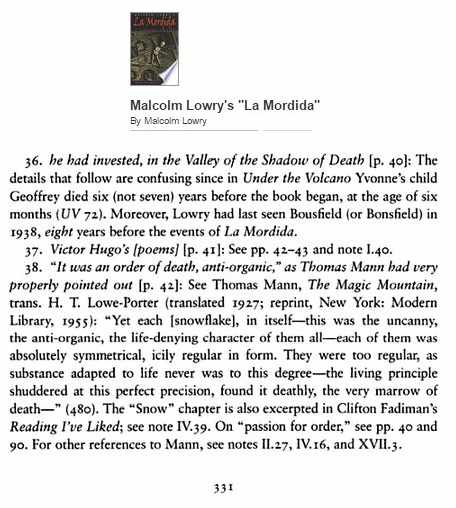

Comments Off on View from the Bottom
Continued from June 17, 2009 —
"I sit now in a little room off the bar
at four-thirty in the morning drinking
ochas and then mescal and writing this
on some Bella Vista notepaper I filched
the other night…."
— Malcolm Lowry, Under the Volcano
See too a search for Snowflake in this journal.
This word may serve as Mark Strand's "Rosebud."
Comments Off on Back to the Real
From "A Piece of the Storm," by the late poet Mark Strand —
A snowflake, a blizzard of one….
From notes to Malcolm Lowry's "La Mordida" —
he had invested, in the Valley of the Shadow of Death….

See also Weyl's Symmetry in this journal.
Comments Off on Investments
The Regular Tetrahedron
The seven symmetry axes of the regular tetrahedron
are of two types: vertex-to-face and edge-to-edge.
Take these axes as the "points" of a Fano plane.
Each of the tetrahedron's six reflection planes contains
two vertex-to-face axes and one edge-to-edge axis.
Take these six planes as six of the "lines" of a Fano
plane. Then the seventh line is the set of three
edge-to-edge axes.
(The Fano tetrahedron is not original with me.
See Polster's 1998 A Geometrical Picture Book , pp. 16-17.)
The Cube
There are three reflection planes parallel to faces
of the cube. Take the seven nonempty subsets of
the set of these three planes as the "points" of a
Fano plane. Define the Fano "lines" as those triples
of these seven subsets in which each member of
the triple is the symmetric-difference sum of the
other two members.
(This is the eightfold cube discussed at finitegeometry.org.)
Comments Off on Two Physical Models of the Fano Plane
Saturday, November 29, 2014
Comments Off on Mark Strand
The title refers to this morning's previous post.

The above links from today's aldaily.com : Cubism, Bernstein, Hell.
Comments Off on Something Missing?
For the late Vladimir Nabokov, author of Pale Fire :
He took his article from a steel file:
"It's accurate. I have not changed her style.
There's one misprint–not that it matters much:
Mountain, not fountain. The majestic touch."

Click for a related Hollywood Reporter story.
Comments Off on Mountain, Fountain
Friday, November 28, 2014
A search for background on the academic
author cited in the previous post yields…
"The debate is, in the words of one professor,
'a struggle for the intellectual soul of Stanford.'"
Some may doubt there is such a thing.
See Marissa Mayer in this journal…
and in Vogue (a story dated August 16, 2013)—

Comments Off on The Soul of Stanford
From PhDTree.org —
“Paradox lust”: the fortunate fall
according to Joyce in finnegans wake
Gerald Gillespie
Journal Article Neohelicon 38(1) 161-175 (2011)
No abstract.
DOI: 10.1007/s11059-011-0092-y
Download: Full Text PDF
Comments Off on Religion for Academics
Comments Off on A Key for the Twins*
Continued from Friday the 13th of June, 2014 :

"It's going to be accomplished in steps,
this establishment of the Talented
in the scheme of things."
— To Ride Pegasus ,
by Anne McCaffrey (Radcliffe '47)
Related material:

Click Zenna Henderson's dates for
an informative essay from April 5, 2009.
See also posts on, or about, that date in this journal.
Comments Off on Former-Day Saint
Kristen Wiig, Girl Reporter…
.. in The Skeleton Twins—

"I've got news for you."
Co-starring Bill Hader as Her —

Comments Off on For Black Friday
Continued from Finder (Sept. 23, 2014)
"I wrote another book!" — Harlan Kane

From an online NY Times obituary this morning :
"At Newsweek, Mr. Bernstein and other top editors
became known as the Flying Wallendas for
managing tasks on deadline with the seeming ease
of the famed trapeze artists. In a tribute, staff
members framed a circus poster of the high-wire
troupe and hung it in his office."
Wikipedia on Bernstein's son-in-law :
"Married to New York Times correspondent Nina Bernstein,
Huyssen is also a longtime friend of Nobel Prize-winning
Turkish novelist Orhan Pamuk, and often hosts him when
the writer comes to the US. The two teach an undergraduate
class together at Columbia called 'Words and Pictures,'
which examines problems of visual representation in literature,
particularly theories of ekphrasis."
Ekphrasis for Bernsteins:

The Wonder Show of the World!
See also Miniature Prize —

"Rosebud."
Comments Off on Words and Pictures
Alexander Grothendieck, Récoltes et Semailles , 18.5.9.5. e, p. 1181 :
Pour mettre la joie à son comble, j’ajoute que le dénommé Saavedra
semble avoir disparu de la circulation sans plus laisser aucune trace….
Du coup, l’histoire prend des allures de sombre intrigue policière.
Man of La Mancha :
"Who knows where madness lies?"
An author quoted here at 10 PM ET Monday, Nov. 24, 2014 :

And then there is author Dan McGirt :
|
November Seventh, 2013 :
It sounded fun, so I signed up — and soon learned writing a story set in someone else’s fictional world presents certain … challenges. It was an enjoyable experience, yet very different than being able to write and run with whatever crazy idea pops into my head.
Trying to capture the feel of a game that is more based on action and blowing stuff up than on deep character moments (not that I would know much about that … ) was also a challenge. I experimented with things like using comic book sound effects, lean descriptions (do I really need to describe a fireball spell in detail?) and other tricks to keep things moving.
I also got to add to Magicka lore. Often the answer to my questions about some bit of in-world history or “fact” was “Make something up.” So I did! (Often getting a response of … “Odin’s onions, no! You can’t do that!”) So I was thrilled and excited to contribute in a small way to the development of Midgård.
The result is Magicka: The Ninth Element , in which four young Wizards are sent on a quest to pursue the mysterious Purple Wizard who has stolen a powerful artifact from the Order of Magick.
Which powerful artifact? No one is quite sure (for reasons explained in the story).
What does it do? Again, unclear. But it can’t be good.
Thus our heroes Davlo, Grimnir, Fafnir and Tuonetar set out on their quest — and promptly go off the map. (I’m not even kidding. The Midgård map in the front of the book will of little use to you. But it’s pretty!)
Will they survive the dangers of the Unmapped Lands? Will they catch the Purple Wizard in time? Will they save the world? Read the book to find out!
|
Comments Off on Off the Map
Thursday, November 27, 2014
For the late novelist P. D. James, author of, among other things,
The Children of Men .
Michael Caine in the film of that book —

Detail —

Raven's Progressive Matrices example —

A quote for tellers of tales —
“There have long been rumors of a mythical Ninth Element
that grants ultimate power to the Wizard who masters it.
The Order of Magick says there is no such thing. But….”
— Website of Magicka: The Ninth Element Novel
Comments Off on In the Details
The New York Times this morning:
Lucien Clergue, Master and Promoter
of Art Photography, Dies at 80.
Clergue reportedly died on November 15.
From Log24 on that date— Un-Art Photography :

From the American Mathematical Society,
another death, also on November 15:
(Click image for further details.)

Midrash by Eliot:

(Click the Eliot quotations to enlarge them.)
Comments Off on Art Photography
Wednesday, November 26, 2014
Comments Off on Mathematics and Narrative
Update of Nov. 30, 2014 —
It turns out that the following construction appears on
pages 16-17 of A Geometrical Picture Book , by
Burkard Polster (Springer, 1998).

"Experienced mathematicians know that often the hardest
part of researching a problem is understanding precisely
what that problem says. They often follow Polya's wise
advice: 'If you can't solve a problem, then there is an
easier problem you can't solve: find it.'"
—John H. Conway, foreword to the 2004 Princeton
Science Library edition of How to Solve It , by G. Polya
For a similar but more difficult problem involving the
31-point projective plane, see yesterday's post
"Euclidean-Galois Interplay."
The above new [see update above] Fano-plane model was
suggested by some 1998 remarks of the late Stephen Eberhart.
See this morning's followup to "Euclidean-Galois Interplay"
quoting Eberhart on the topic of how some of the smallest finite
projective planes relate to the symmetries of the five Platonic solids.
Update of Nov. 27, 2014: The seventh "line" of the tetrahedral
Fano model was redefined for greater symmetry.
Comments Off on A Tetrahedral Fano-Plane Model
Update of Nov. 30, 2014 —
For further information on the geometry in
the remarks by Eberhart below, see
pp. 16-17 of A Geometrical Picture Book ,
by Burkard Polster (Springer, 1998). Polster
cites a different article by Lemay.
A search for background to the exercise in the previous post
yields a passage from the late Stephen Eberhart:
|
The first three primes p = 2, 3, and 5 therefore yield finite projective planes with 7, 13, and 31 points and lines, respectively. But these are just the numbers of symmetry axes of the five regular solids, as described in Plato's Timaeus : The tetrahedron has 4 pairs of face planes and corner points + 3 pairs of opposite edges, totalling 7 axes; the cube has 3 pairs of faces + 6 pairs of edges + 4 pairs of corners, totalling 13 axes (the octahedron simply interchanges the roles of faces and corners); and the pentagon dodecahedron has 6 pairs of faces + 15 pairs of edges + 10 pairs of corners, totalling 31 axes (the icosahedron again interchanging roles of faces and corners). This is such a suggestive result, one would expect to find it dealt with in most texts on related subjects; instead, while "well known to those who well know such things" (as Richard Guy likes to quip), it is scarcely to be found in the formal literature [9]. The reason for the common numbers, it turns out, is that the groups of symmetry motions of the regular solids are subgroups of the groups of collineations of the respective finite planes, a face axis being different from an edge axis of a regular solid but all points of a projective plane being alike, so the latter has more symmetries than the former.
[9] I am aware only of a series of in-house publications by Fernand Lemay of the Laboratoire de Didactique, Faculté des Sciences de I 'Éducation, Univ. Laval, Québec, in particular those collectively titled Genèse de la géométrie I-X.
— Stephen Eberhart, Dept. of Mathematics,
California State University, Northridge,
"Pythagorean and Platonic Bridges between
Geometry and Algebra," in BRIDGES: Mathematical
Connections in Art, Music, and Science , 1998,
archive.bridgesmathart.org/1998/bridges1998-121.pdf
|
Eberhart died of bone cancer in 2003. A memorial by his
high school class includes an Aug. 7, 2003, transcribed
letter from Eberhart to a classmate that ends…
… I earned MA’s in math (UW, Seattle) and history (UM, Missoula) where a math/history PhD program had been announced but canceled. So 1984 to 2002 I taught math (esp. non-Euclidean geometry) at C.S.U. Northridge. It’s been a rich life. I’m grateful.
Steve
|
See also another informative BRIDGES paper by Eberhart
on mathematics and the seven traditional liberal arts.
Comments Off on Class Act
Tuesday, November 25, 2014
For previous remarks on this topic, as it relates to
symmetry axes of the cube, see previous posts tagged Interplay.
The above posts discuss, among other things, the Galois
projective plane of order 3, with 13 points and 13 lines.

These Galois points and lines may be modeled in Euclidean geometry
by the 13 symmetry axes and the 13 rotation planes
of the Euclidean cube. They may also be modeled in Galois geometry
by subsets of the 3x3x3 Galois cube (vector 3-space over GF(3)).
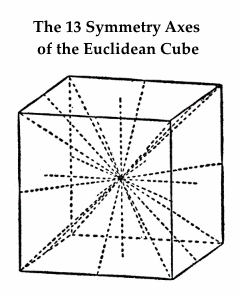

The 3×3×3 Galois Cube
Exercise: Is there any such analogy between the 31 points of the
order-5 Galois projective plane and the 31 symmetry axes of the
Euclidean dodecahedron and icosahedron? Also, how may the
31 projective points be naturally pictured as lines within the
5x5x5 Galois cube (vector 3-space over GF(5))?
Update of Nov. 30, 2014 —
For background to the above exercise, see
pp. 16-17 of A Geometrical Picture Book ,
by Burkard Polster (Springer, 1998), esp.
the citation to a 1983 article by Lemay.
Comments Off on Euclidean-Galois Interplay
Monday, November 24, 2014

"We tried to create new realities overnight,
careful sets of words that resemble advertising slogans
in memorability and repeatability."
… Our Most Important Product …

"Omega is as real as we need it to be."
— Burt Lancaster in Sam Peckinpah's last film
Comments Off on “What Reality?”
Continued from Tuesday, November 18, 2014
International poster for the 2010 film "Black Swan"—

"Death is a black swan." — Graciela Chichilnisky
Comments Off on Homemade Aesthetics
Comments Off on Metaphysician in the Dark
Sunday, November 23, 2014
Wallace Stevens in "An Ordinary Evening in New Haven"
(1950) on "The Ruler of Reality" —
"Again, 'He has thought it out, he thinks it out,
As he has been and is and, with the Queen
Of Fact, lies at his ease beside the sea.'"
One such scene, from 1953 —

Another perspective, from "The Osterman Weekend" (1983) —

Comments Off on Remarks on Reality

Corrections to the NY Times obituary of Alexander Grothendieck
are shown below. For the original Sunday, Nov. 16, NY Times
print obituary (with its online date, Nov. 14), see a copy taken
from a weblog.


For another poetic remark in memory of Grothendieck,
see a Log24 post from November 13, the day of his death.
Comments Off on Style
Saturday, November 22, 2014
See the easy grace link in this morning's previous post.
See also Michael Dubruiel and Log24 posts of Feb. 3
and Feb. 9, 2009.
Comments Off on About Nothing
Welcome to the Garden Club, Pilgrim

"A journalist with a literary bent, Mr. Eder wrote with an easy grace
and a practiced eye for detail. In 1974, he assessed a cultural
malaise in England during an economic downturn.
'In the West Country town of Hereford,' he began, 'the president
of a women’s club told a year-end meeting that the January bingo
game would be canceled to save electricity. Then she proposed a
New Year’s resolution. "Let us all work to get England back on her
dear old feet," she said and bumped down pinkly into her chair,
overwhelmed by applause.'" — Bruce Weber, NY Times

See also Bingo in this journal.
Comments Off on The November 22 Candidate
Friday, November 21, 2014
“When Three Into One Equals More” — New York Times headline

See also Trinity in this journal. From that search:
… The actor is
A metaphysician in the dark….
— Wallace Stevens,
“Of Modern Poetry“
Comments Off on More
Thursday, November 20, 2014
Comments Off on Graduate Director
Continued from Tuesday, Nov. 18

The above conclusion of a NY Times obituary
about a Monday death may also serve as the
missing conclusion of Monday's "A Search for
Missing Pieces" —

Related material starring Einstein and
Thomas Mann: "A Riddle for Davos."
Comments Off on The Manchurian Candidate
Wednesday, November 19, 2014
Harold Rosenberg, "Art and Words,"
The New Yorker , March 29, 1969. From page 110:
"An advanced painting of this century inevitably gives rise
in the spectator to a conflict between his eye and his mind;
as Thomas Hess has pointed out, the fable of the emperor's
new clothes is echoed at the birth of every modemist art
movement. If work in a new mode is to be accepted, the
eye/mind conflict must be resolved in favor of the mind;
that is, of the language absorbed into the work. Of itself,
the eye is incapable of breaking into the intellectual system
that today distinguishes between objects that are art and
those that are not. Given its primitive function of
discriminating among things in shopping centers and on
highways, the eye will recognize a Noland as a fabric
design, a Judd as a stack of metal bins— until the eye's
outrageous philistinism has been subdued by the drone of
formulas concerning breakthroughs in color, space, and
even optical perception (this, too, unseen by the eye, of
course). It is scarcely an exaggeration to say that paintings
are today apprehended with the ears. Miss Barbara Rose,
once a promoter of striped canvases and aluminum boxes,
confesses that words are essential to the art she favored
when she writes, 'Although the logic of minimal art gained
critical respect, if not admiration, its reductiveness allowed
for a relatively limited art experience.' Recent art criticism
has reversed earlier procedures: instead of deriving principles
from what it sees, it teaches the eye to 'see' principles; the
writings of one of America's influential critics often pivot on
the drama of how he failed to respond to a painting or
sculpture the first few times he saw it but, returning to the
work, penetrated the concept that made it significant and
was then able to appreciate it. To qualify as a member of the
art public, an individual must be tuned to the appropriate
verbal reverberations of objects in art galleries, and his
receptive mechanism must be constantly adjusted to oscillate
to new vocabularies."
New vocabulary illustrated:
Graphic Design and a Symplectic Polarity —

Background: The diamond theorem
and a zero system .
Comments Off on The Eye/Mind Conflict
Tuesday, November 18, 2014
Tom Wolfe in The Painted Word (1975):
“It is important to repeat that Greenberg and Rosenberg
did not create their theories in a vacuum or simply turn up
with them one day like tablets brought down from atop
Green Mountain or Red Mountain (as B. H. Friedman once
called the two men). As tout le monde understood, they
were not only theories but … hot news,
straight from the studios, from the scene.”
| “Parable of American Painting,” 1954 — From The Tradition of the New , by Harold Rosenberg
“In this essay Rosenberg set out to explain what he believed to be definitively American about Abstract Expressionism. He did so by drawing on the American Revolutionary War for his metaphors, likening the new Americans to the coonskin trappers whose knowledge of their terrain enabled them to pick off the British soldiers (Redcoats), who followed the dictates of their military training. The professionally- trained soldiers were defeated because, as Rosenberg states, ‘They were such extreme European professionals … they did not even see the American trees.’ ‘Redcoatism’ was, Rosenberg argued, a symptom of the old European world’s stubborn rejection of the new. It did at one time also ‘[dominate] the history of American art,’ he wrote, but with the advent of Abstract Expressionism, times had changed. And just as the Coonskins were victorious because they stood apart from the professional military, so the new American art was triumphant because, as Rosenberg saw it, it marked a profound break with the traditions of European art.”
— TheArtStory.org |

Lectures at Bennington, 1971
|
For example:

Art adapted today from the Google search screen. Discuss.
Comments Off on For the Green Mountain Girls
Continues.

Prequel from 1961 (click image for context):

Detail that may be interpreted as the Chinese
3×3 "Holy Field" and a Chinese temple bell—

"Ting-a-ling." — Kurt Vonnegut.
Comments Off on The Abacus Conundrum…

Hexagram 35:
Progress
"Then came a 'Robot Psychologist,' known as a Psychological Matrix Rotator,
developed for the Department of Defense. It is still used to literally 'see' that
the right man gets the right Army job."
— Ronald Reagan, 1961 GE Sales Meeting
"Always with a little humor." — Yen Lo
In memory of Dr. Irving Peress,
who reportedly died on Thursday,
November 13, 2014.
Comments Off on Our Most Important Product
Monday, November 17, 2014
A detail from the image search below —

A Google image search today for
“portal del aguila de oro” “bella vista” —
Click for a larger (4.2 MB) version.

See also yesterday’s post.
Comments Off on A Search for Missing Pieces
Sunday, November 16, 2014
“Bit by bit, putting it together.
Piece by piece, working out the vision night and day.
All it takes is time and perseverance
With a little luck along the way.”
— Stephen Sondheim

See also, in this journal, 528, 1963, 522, and 3273.
Comments Off on Along the Way
Saturday, November 15, 2014
Alexander Grothendieck, Récoltes et Semailles , 18.5.9.5. e, p. 1181:
Pour mettre la joie à son comble, j’ajoute que le dénommé Saavedra
semble avoir disparu de la circulation sans plus laisser aucune trace….
Du coup, l’histoire prend des allures de sombre intrigue policière.
Google Translate version:
To the joy at its height, I would add that the so-called Saavedra
seems to have disappeared from circulation without leaving any trace….
Suddenly, the story looks like a dark detective story.
Or horror film —
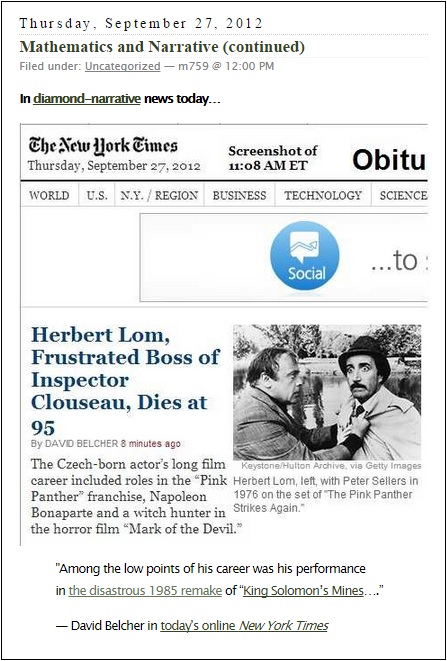
Comments Off on A Dark Detective Story
(Continued)
A Math Enigma —

Grothendieck reportedly died on Thursday, November 13, 2014.
From this journal a year earlier:
A German Enigma —

After clicking on the link “a grave intellectual whole” from the Nov. 13, 2013, post
see also Benedict Cumberbatch’s less serious approach to Bletchley Park:
“I want to see this film; this film’s been up my ass for the last five years.”
Comments Off on Enigma Variations
Friday, November 14, 2014
“What happens when you mix the brilliant wit of Noel Coward
with the intricate plotting of Agatha Christie? Set during a
weekend in an English country manor in 1932, Death by Design
is a delightful and mysterious ‘mash-up’ of two of the greatest
English writers of all time. Edward Bennett, a playwright, and
his wife Sorel Bennett, an actress, flee London and head to
Cookham after a disastrous opening night. But various guests
arrive unexpectedly….”
— Samuel French (theatrical publisher) on a play that
opened in Houston on September 9, 2011.
Related material:
Comments Off on Another Opening, Another Show
A paper from 1976 on symplectic torsors and finite geometry:

A pdf is now available:
FINITE GEOMETRIES IN THE THEORY OF THETA CHARACTERISTICS
Autor(en): Rivano, Neantro Saavedra
Objekttyp: Article
Zeitschrift: L’Enseignement Mathématique
Band (Jahr): 22 (1976)
Heft 1-2: L’ENSEIGNEMENT MATHÉMATIQUE
PDF erstellt am: 14.11.2014
Persistenter Link: http://dx.doi.org/10.5169/seals-48185
(Received by the journal on February 20, 1976.)
Saavedra-Rivano was a student of Grothendieck, who reportedly died yesterday.

Comments Off on Some Symplectic History
Thursday, November 13, 2014
“Alexandre Grothendieck est mort jeudi matin
à l’hôpital de Saint-Girons (Ariège), à l’âge de 86 ans.”
Update of 6: 16 PM ET: A memorial of sorts, from May 27 this year:

Comments Off on Mort de Grothendieck
Yesterday's post and recent Hollywood news suggest
a meditation on a Progressive Matrix —
Oct. 12-14, 2005:


Click to enlarge.
"My card."
Structurally related images —
A sample Raven's Progressive Matrices test item
(such items share the 3×3 structure of the hash symbol above):

Structural background —

Comments Off on Progressive Matrix
Wednesday, November 12, 2014
The title is a phrase from yesterday's post.
An example of harrowing cuteness:
Charlize Theron in "Young Adult" (2011) —

Related material for older adults: Ravenna and Nietzsche.
Comments Off on Harrowing Cuteness
Tuesday, November 11, 2014
Comments Off on Vonnegut’s Birthday
Monday, November 10, 2014

Remember him to Herald Square.

Comments Off on Meanwhile, Back in 1962…
"We live entirely, especially if we are writers, by the imposition
of a narrative line upon disparate images…." — Joan Didion
Narrative Line:


Disparate images:

Exercise:
Can the above narrative line be imposed in any sensible way
upon the above disparate images?
Comments Off on Narrative Line
Sunday, November 9, 2014
The Ideas
“We tell ourselves stories in order to live….
We interpret what we see, select the most workable
of multiple choices. We live entirely, especially if we
are writers, by the imposition of a narrative line upon
disparate images, by the ‘ideas’ with which we have
learned to freeze the shifting phantasmagoria
which is our actual experience.” — Joan Didion |
See Didion and the I Ching and posts tagged Plato in China .
Comments Off on Sermon
“There exists a considerable literature
devoted to the Lo shu , much of it infected
with the kind of crypto-mystic twaddle
met with in Feng Shui.”
— Lee C. F. Sallows, Geometric Magic Squares ,
Dover Publications, 2013, page 121
Cf. Raiders of the Lost Theorem, Oct. 13, 2014.
See also tonight’s previous post and
“Feng Shui” in this journal.
Comments Off on Twaddle
Saturday, November 8, 2014
Comments Off on At 11:59*
Friday, November 7, 2014
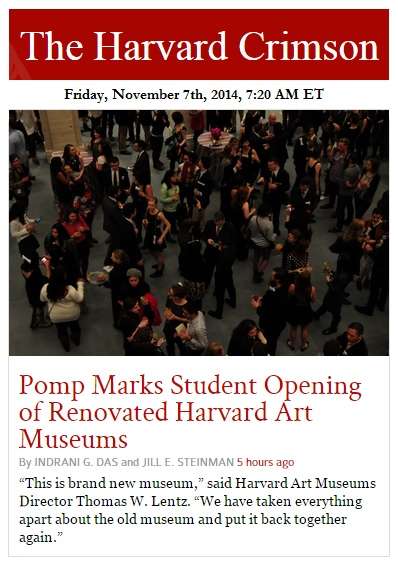
Back together, but missing an article.
“An article (abbreviated ART) is a word (or prefix or suffix)
that is used with a noun to indicate the type of reference
being made by the noun.” — Wikipedia
Perhaps Tommy Lee Jones has it.
“Geometry was very important to us in this movie.”
Comments Off on The Missing ART
Continues.
There is such a thing as an MBTI Tesseract.
See a thread at http://www.typologycentral.com/forums/
from August 17 and 18, 2010.
See also this journal on those dates: The Kermode Game.
Comments Off on The Crosswicks Curse…
Thursday, November 6, 2014
(Continued)
“This setting of the Ave Verum Corpus text was composed
to celebrate the feast of Corpus Christi .” — Wikipedia

“Ave Verum Corpus .”— Madison in the BBC America TV series
“Intruders,” Season 1, Episode 3: “Time Has Come Today.”
See also the Eucharistic meditation of Feb. 13, 2006, linked to in yesterday’s post
on Guy Fawkes Day. (That British holiday originally commemorated the Catholic
Gunpowder Plot of 1605.)
Comments Off on Working Backward
Wednesday, November 5, 2014
Continues.
From the first of previous Log24 posts tagged “Dark Fields”—
“A link in memory of Donald G. Higman,
dead on Feb. 13, 2006,
the day after Lincoln’s birthday:
On the Graphs of Hoffman-Singleton and Higman-Sims.
His truth is marching on.”
See also Foundation Square (October 25, 2014).
Comments Off on Dark Fields…
Monday, November 3, 2014
A link to “Nine Tailors” in this journal may serve as
a memorial to the late David M. Abshire, who
reportedly died at 88 on Halloween.
See also tonight’s previous post and a remark by
Mira Sorvino in her version of The Great Gatsby .
Comments Off on Plan 9 Continues…
Courtesy of Mira Sorvino.
Enter Madison :
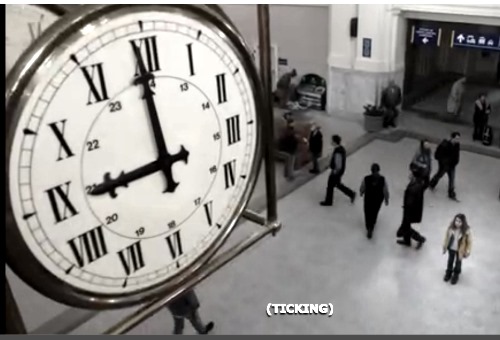
From “Intruders,” BBC America, Season 1, Episode 2, at 1:07 of 43:31.
“You sure know how to show a girl a good time.“
* The title is a reference to a Wisconsin-related Halloween post.
Comments Off on Wisconsin Death Trip*
A weblog reports Chris Rock's remarks
on Saturday Night Live this past weekend:
"It’s America, we commercialize everything.
Look at what we did to Christmas.
Christmas. Christmas is Jesus’ birthday.
It’s Jesus’ birthday. Now, I don’t know Jesus
but from what I’ve read, Jesus is the least
materialistic person to ever roam the earth.
No bling on Jesus.
Jesus kept a low profile and we turned his
birthday into the most materialistic day of the
year. Matter of fact, we have the Jesus birthday
season. It’s a whole season of materialism.
Then, at the end of the Jesus birthday season
we have the nerve to have an economist come
on TV and tell you how horrible the Jesus birthday
season was this year. Oh, we had a horrible Jesus’
birthday this year. Hopefully, business will pick up
by his Crucifixion.”
Related music and image:
"Show us the way to the next little girl …"

Natalie Wood in "Miracle on 34th Street" (1947)
Related non-materialistic meditations:
The Rhetoric of Abstract Concepts and Gods and Giants.
Comments Off on Gods and Giants
From a post of June 3, 2013:
New Yorker editor David Remnick at Princeton today
(from a copy of his prepared remarks):
“Finally, speaking of fabric design….”
I prefer Tom and Harold:
Tom Wolfe in The Painted Word —
“I am willing (now that so much has been revealed!)
to predict that in the year 2000, when the Metropolitan
or the Museum of Modern Art puts on the great
retrospective exhibition of American Art 1945-75,
the three artists who will be featured, the three seminal
figures of the era, will be not Pollock, de Kooning, and
Johns-but Greenberg, Rosenberg, and Steinberg.
Up on the walls will be huge copy blocks, eight and a half
by eleven feet each, presenting the protean passages of
the period … a little ‘fuliginous flatness’ here … a little
‘action painting’ there … and some of that ‘all great art
is about art’ just beyond. Beside them will be small
reproductions of the work of leading illustrators of
the Word from that period….”
Harold Rosenberg in The New Yorker (click to enlarge)—

From Gotay and Isenberg, “The Symplectization of Science,”
Gazette des Mathématiciens 54, 59-79 (1992):
“… what is the origin of the unusual name ‘symplectic’? ….
Its mathematical usage is due to Hermann Weyl who,
in an effort to avoid a certain semantic confusion, renamed
the then obscure ‘line complex group’ the ‘symplectic group.’
… the adjective ‘symplectic’ means ‘plaited together’ or ‘woven.’
This is wonderfully apt….”
Symplectic :

— Steven H. Cullinane,
diamond theorem illustration
Comments Off on The Rhetoric of Abstract Concepts
Sunday, November 2, 2014
"Macy’s Herald Square occupies a singular place
in American retailing." — NY Times today, in print
on page BU1 of the New York edition with the headline:
Makeover on 34th Street .
A Singular Time:
See Remember Me to Herald Square, at noon on
August 21, 2014, and related earlier Log24 posts.
Also on Aug. 21, 2014: from a blog post, 'Tiles,' by
Theo Wright, a British textile designer —

The 24 tile patterns displayed by Wright may be viewed
in their proper mathematical context at …
http://www.diamondspace.net/about.html:

Comments Off on A Singular Place
… there is a path. — Malcolm Lowry
Comments Off on Right Through Hell
Saturday, November 1, 2014
“We are not saints.” — Alcoholics Anonymous , Chapter 5

The New York Times on AA’s co-founder Bill Wilson in 1934:

Click for the rest of the story.
Comments Off on Not Saints
Comments Off on All Saints’ Day


















































































